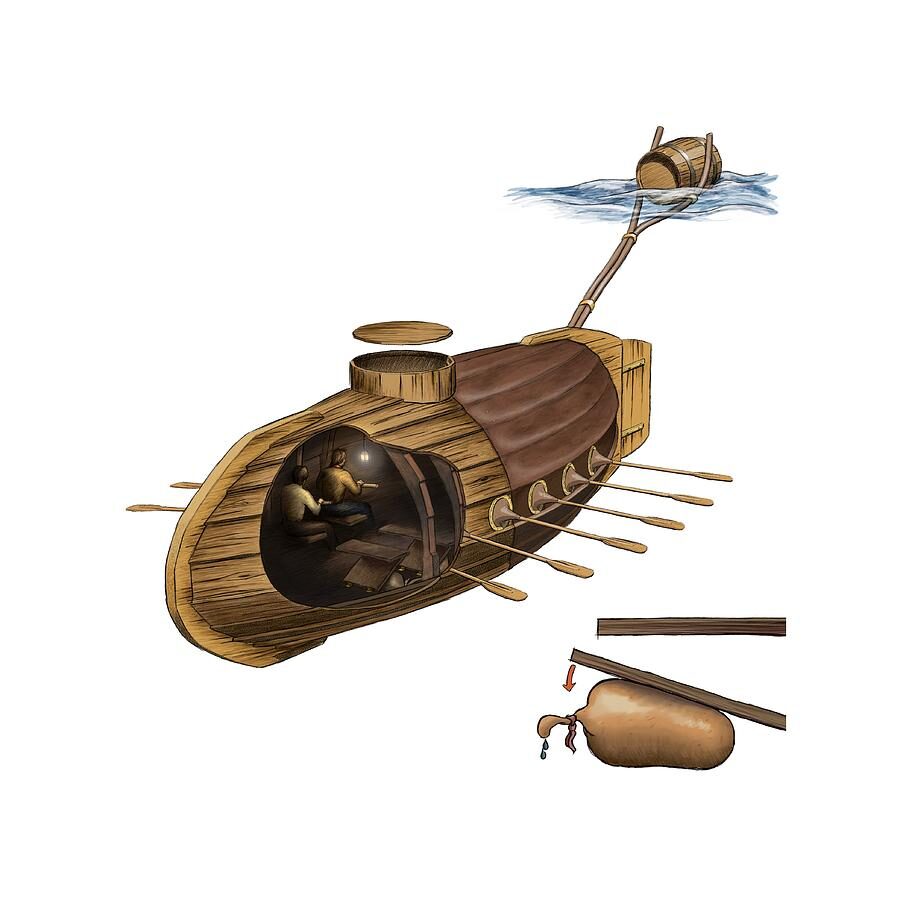
Introduction:
The invention of submarines represents a remarkable journey through human ingenuity and the relentless pursuit of exploration beneath the waves. From ancient myths of underwater vessels to the sophisticated machines of modern warfare, the evolution of submarines reflects humanity’s desire to conquer the depths of the ocean. Early concepts can be traced back to antiquity, where legends tell of Alexander the Great descending in a primitive diving bell. However, it was not until the 17th century that practical designs began to emerge. The Dutch inventor Cornelius Drebbel constructed the first navigable submarine in the early 1600s, demonstrating its potential before the astonished eyes of King James I. This marked the beginning of a new era, where the military applications of underwater craft began to take shape.
Early Concepts and Prototypes
- 1578: The first recorded design for a submarine was proposed by William Bourne, an English mathematician and former Royal Navy gunner. He envisioned a completely enclosed wooden boat that could be submerged and rowed underwater, although this design was never built.
- 1620-1624: Cornelius Drebbel, a Dutch inventor, constructed the first navigable submarine based on Bourne’s concept. His submarine was made of wood and covered in greased leather, allowing it to dive to depths of 12 to 15 feet. Drebbel successfully demonstrated his submarine in the Thames River, even taking King James I on a test dive.


Military Applications
- 1775: The Turtle, designed by American inventor David Bushnell, became the first submarine used in warfare. This hand-powered vessel attempted to attach explosive charges to the hull of British ships during the American Revolutionary War, although it was not successful in its mission.

- 1800: Robert Fulton, an American engineer, built the Nautilus, a submarine designed for the French Navy. This vessel featured a hand-cranked propeller and could submerge by taking water into ballast tanks. Fulton’s work laid the groundwork for future submarine designs.

19th Century Innovations
- 1864: The Confederate submarine H.L. Hunley became the first submarine to successfully sink an enemy warship, the USS Housatonic, during the American Civil War. This marked a significant advancement in submarine warfare capabilities.

- 1898: The first successful electrically powered submarine, the Resurgam, was designed by Reverend George Garrett in Britain. It was intended for use against enemy ships and demonstrated the potential of electric power for underwater vessels.

20th Century Developments
- 1900: The U.S. Navy commissioned its first submarine, the USS Holland (SS-1), which incorporated modern torpedoes and was a significant step in the evolution of submarines as military assets.

- 1955: The launch of the USS Nautilus (SSN-571), the first nuclear-powered submarine, revolutionized submarine technology. It could remain submerged for extended periods and travel long distances without surfacing, marking a new era in naval warfare.

Working Principles of submarines
Submarines operate based on fundamental principles of physics, primarily utilizing Archimedes’ principle to achieve buoyancy control and maneuverability underwater. Here’s a detailed explanation of their working principles:
Buoyancy and Archimedes’ Principle
At the core of submarine operation is Archimedes’ principle, which states that an object submerged in a fluid experiences an upward buoyant force equal to the weight of the fluid displaced by it. Submarines are designed to manipulate their buoyancy to dive or surface in the water.
- Floating and Diving: When a submarine is floating on the surface, it displaces a volume of water equal to its weight. To dive, the submarine takes in water into its ballast tanks, increasing its overall weight. Once the weight of the submarine exceeds the buoyant force acting on it, it begins to sink.
- Submerging: As the submarine takes in water, it becomes denser than the surrounding water, allowing it to submerge. The submarine can control its depth by adjusting the amount of water in its ballast tanks.
- Surfacing: To surface, the submarine expels water from its ballast tanks, typically using compressed air. This reduction in weight allows the buoyant force to lift the submarine back to the surface.
Control and Stability
Submarines also employ various mechanisms to maintain stability and control their orientation while submerged:
- Hydrodynamic Surfaces: Submarines are equipped with diving planes and rudders that help control depth and direction. These surfaces can be adjusted to create lift or drag, allowing the submarine to ascend, descend, or steer.
- Trim Tanks: These tanks help balance the submarine by redistributing water within the vessel. By adjusting the water in trim tanks located at the bow or stern, the submarine can maintain a level position or adjust its angle.
Pressure Hull
The pressure hull is a crucial component of a submarine, designed to withstand the immense pressure of deep water. It is typically made from high-strength steel or titanium and is shaped to minimize resistance while maximizing structural integrity.

Applications of Submarines
Submarines have a wide range of applications, both military and civilian. Here are some of the key applications of submarines:
Military Applications
- Patrol and Surveillance: Submarines are used to patrol ocean waters and monitor enemy activities. Their stealth capabilities allow them to operate undetected for extended periods.
- Attack: Military submarines are equipped with missiles and torpedoes to attack enemy ships and submarines during wartime.
- Nuclear Deterrence: Ballistic missile submarines (SSBNs) serve as a strategic deterrent by carrying nuclear-armed missiles. They provide a secure second-strike capability.
Civilian Applications
- Scientific Research: Smaller submarines are used by researchers and explorers to study the underwater world. They are equipped with cameras, robotic arms, and other tools to aid in scientific exploration.
- Salvage and Rescue Operations: Submarines can be used for search and rescue missions, as well as salvage operations to recover lost or sunken objects from the seafloor.
- Submarine Cable Applications: Submarine cables are used for various applications, such as telecommunications systems. New applications are created by combining cable, repeaters, and branching units designed for these systems.
- Submarine Sand Ridge Studies: Submarine sand ridges are studied to understand the geological and hydrological processes that shape continental shelves around the world.

FAQs
Here are some frequently asked questions about submarines:
What is the difference between a submarine and a submersible?
The main difference is that a submarine is a self-propelled, crewed vessel capable of independent underwater operation, while a submersible is a small underwater vehicle that relies on a surface ship for power, life support, and transportation.
How do submarines dive and surface?
Submarines use ballast tanks that can be flooded with water to increase their weight and submerge. To surface, the tanks are blown free of water using compressed air, reducing the overall weight and allowing the sub to rise.
What is the deepest depth a submarine can reach?
The deepest point in the ocean is the Challenger Deep in the Mariana Trench, which reaches nearly 11,000 meters (36,000 feet). Only a few specially designed deep-diving submersibles have reached this depth, such as the Deepsea Challenger in 2012.
How long can a submarine stay submerged?
The length of time a submarine can remain submerged depends on factors like the type of propulsion system, size of the vessel, and supplies onboard. Nuclear-powered submarines can theoretically stay submerged indefinitely, while diesel-electric subs are limited by their air supply and battery life.
What are some of the most famous submarines in history?
Some notable submarines include:
- USS Nautilus (SSN-571): First nuclear-powered submarine, launched in 1954
- USS Triton (SSRN-586): First submarine to execute a submerged circumnavigation of the globe in 1960
- USS Thresher (SSN-593): Lost with all hands in 1963, leading to major submarine safety improvements
- USS Nautilus (SSN-571): First submarine to reach the geographic North Pole in 1958
How many countries operate submarines today?
As of 2023, over 40 countries operate submarines, with the United States, Russia, China, the United Kingdom, and France possessing the largest submarine fleets. Other notable submarine operators include India, Iran, North Korea, and Pakistan.
Read Related Post
A Robotic Technology That Can Discover Lung Cancer Early


